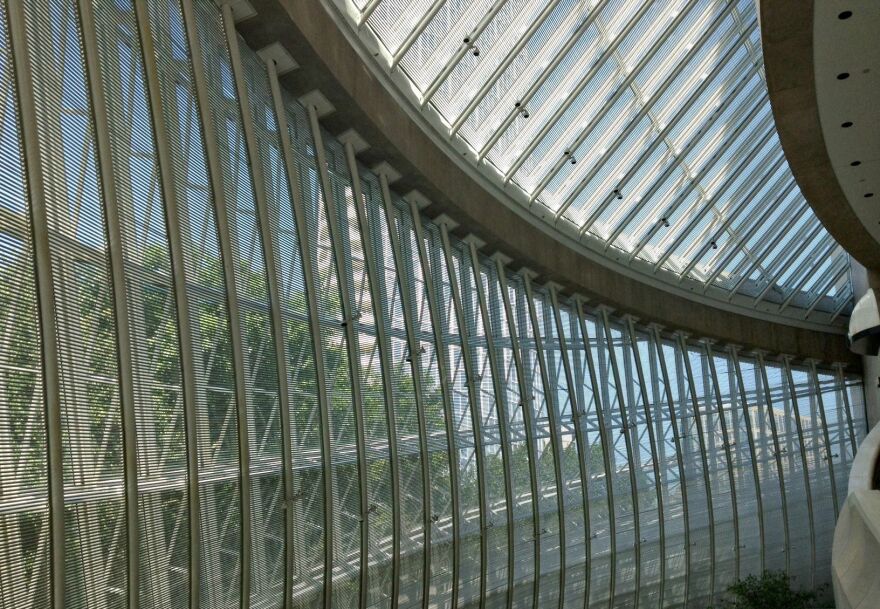The Meyerson has been named one of the best orchestral halls in the world. The home of the Dallas Symphony Orchestra has been visited by former presidents Barack Obama and George W. Bush, and renowned artists like cellist Yo-Yo Ma and soul musician Ray Charles have performed on its stages.
Art&Seek’s Dane Walters created a 360-degree virtual tour of the Meyerson, with sweeping views of every corner of the building, from backstage to inside the massive organ. The tour’s host is Morton H. Meyerson, who oversaw construction of the hall that bears his name.
Here are just a few of the behind-the-scenes stories Morton H. Meyerson shares in the virtual tour.

1. Architect I.M. Pei's Pitch Story
The Meyerson was designed by world-renowned architect I.M. Pei, who designed landmarks like the Louvre’s glass pyramid and the East building of the National Gallery of Art.. It seemed like destiny, but many would be surprised to know Pei almost didn’t design the Meyerson.
Pei’s architecture firm was one of 10 finalists selected from a pool of 100 to pitch to the Meyerson selection committee in-person, but Pei refused to engage in what he called a “beauty walk” and dropped out of the competition.
The committee initially voted 5-2 in favor of a Michigan firm,with the naysayers being Meyerson and Stanley Marcus, the former president of Neiman Marcus. Ultimately, Meyerson wielded his influence as chairman and declared the need for a unanimous vote.
That meant the search for the right architecture firm was back on. While brainstorming candidates, a committee member suggested Pei again. When Pei was asked a second time to pitch in person, he finally agreed to the surprise of the committee.
Meyerson said Pei entered the meeting looking like he “stepped out of a magazine,” with his speckled horn-rimmed glasses and tailored suit. Then Meyerson recalled Pei gave “one of the greatest sales pitches” he’d ever heard before:
“Here’s what he said and this is roughly a quote from him…‘I can tell you this, if I had the right skills and if I was selected, I have one symphony hall in my heart. I’ve never done one and I’ve never worked on one, but this is the only one I’ll ever do. So if you select me, you’ll have the only Pei hall in the world.’”

2. Naming The Hall
When funding for the hall had dried up, Meyerson reached out to his employer, billionaire business magnate Ross Perot, who graciously agreed to donate the $10 million needed for the project.
In talks with Perot, Meyerson suggested naming the hall after Perot’s wife Margot or his recently deceased mother. Instead, Perot proposed naming the hall after Meyerson.
Meyerson still remembers Perot’s convincing argument with a chuckle:
“He said ‘well I got a question for you Mort: do you want the money?’ I said yes, I did. Then he said ‘Then I get to name the hall.’”

3. The Marble Floors
It’s easy to admire the beautiful Italian marble floors of the Meyerson, but the story behind them is more complicated than most visitors might imagine.
Two months away from the symphony hall’s opening, it looked like the marble wouldn’t be ready. To make matters worse, most people in Italy take time off in August — that meant that the marble-cutters wouldn’t be available for a significant portion of an already tight timeline.
Meyerson refused to back down. He sent an intermediary to persuade the union head of the Italian quarry to rally his workers and cut the marble when they’d usually be on vacation.
Myerson also had to leverage some powerful connections. He called American Airlines CEO, Robert Crandall, who packed slabs of marble on flights from Italy to Dallas. Looking back, Meyerson said relationships were really what allowed the symphony hall to come together:
“The reason why this story is interesting is because there are a thousand stories just like this in the building of the symphony hall or any large project. You have to be resourceful and you have to have friends because relationships are more important than money.”

4. Curved Glass Wall
Meyerson said Pei told him this curtain wall was the first in the history of architecture to be designed by a computer. While the final product has become one of the most unique facets of the building, Meyerson was at first skeptical because of the hefty price tag.
When Meyerson asked Pei why it was a necessary addition, Pei simply replied, “because it’s beautiful.” Meyerson said the curved glass curtain wall gives the building its character:
“You’re under one of the most distinctive features of the building. You have not parallel lines, but converging lines that go to a point way away.”

5. The Canopies
The acoustician Russell Johnson designed the four sound-cushioning canopies above the Meyerson’s stage, which enhance the sound quality in the performance hall.
The main canopy weighs 42 tons and the side canopies weigh 15 tons each. Holding up the heavy weight, six or seven cables attached to the canopies protect the orchestra below.
“I believe our four canopies makes a tremendous difference and is one of the reasons we’re rated to have the best acoustics in the world.”
You can adjust the canopies on your own through a virtual simulation.
Find more interesting stories about the Meyerson by exploring the 360-degree virtual tour. We’ve put together a guide to help you identify more points of interest throughout the symphony center. You can also learn more about the building’s namesake, Morton H. Meyerson, from his interview with Art&Seek’s Jerome Weeks.
KERA News is made possible through the generosity of our members. If you find this reporting valuable, consider making a tax-deductible gift today. Thank you.



